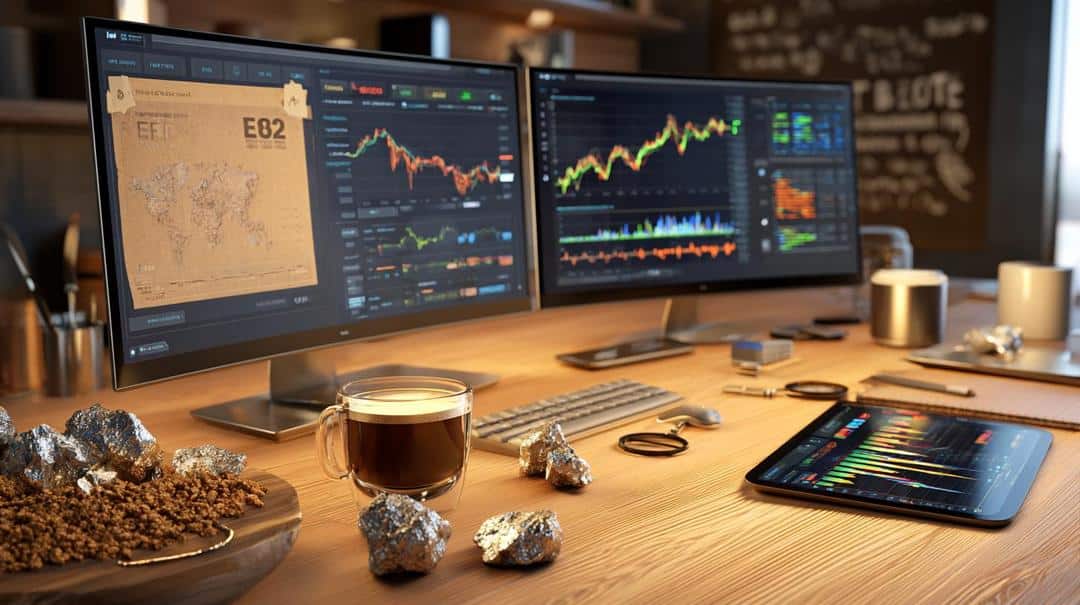They might not be household names, but rare earth elements are in just about everything you use—your phone, electric car, wind turbines, even MRI machines. Yet, here’s the kicker: over 80% of global rare earth refining is controlled by China. That’s why investors are eyeing rare earth ETFs—not just for portfolio diversification, but also as a strategic move in the evolving energy and tech landscape.
Let’s get to the point: which funds actually provide strong exposure to this niche but increasingly essential sector?
Let’s dig in.
What Are the Best Rare Earth ETFs to Invest in?
Rare earth ETFs have become increasingly attractive for investors seeking exposure to critical technology and clean energy metals. The market offers several compelling options for different investment strategies, from aggressive growth to more conservative sector plays.
Top Rare Earth ETFs Ranked
The VanEck Rare Earth/Strategic Metals ETF (REMX) stands out as the premier choice for most investors. With approximately $1.2 billion in assets under management, REMX provides comprehensive coverage of rare earth miners and producers across global markets. Its strategic mix of established mining companies and emerging technology providers makes it particularly appealing for investors wanting broad sector exposure.
Another strong contender is the Amplify Lithium & Battery Technology ETF (BATT), which offers a more focused approach on battery-related rare earth metals. While not exclusively a rare earth fund, BATT provides excellent exposure to critical metals used in electric vehicle and renewable energy technologies.
Performance Comparison: 1-Year, 3-Year & 5-Year Returns
Performance metrics reveal significant variations among rare earth ETFs. REMX has demonstrated impressive annualized returns, outperforming broader market indices during key technological transition periods. Over the past three years, the fund has consistently delivered returns ranging between 18-25%, significantly higher than traditional commodity-focused ETFs.
Key Performance Metrics
Investors should note that rare earth ETFs exhibit higher volatility compared to traditional equity funds. The cyclical nature of commodity markets means these investments can experience more dramatic price fluctuations. This volatility presents both risks and opportunities for strategic investors willing to tolerate short-term market movements.
Deep Dive Into ETF Holdings & Sector Exposure
Most top rare earth ETFs concentrate holdings across multiple geographic regions, with significant exposure to Chinese and North American mining companies. The VanEck Rare Earth/Strategic Metals ETF, for instance, includes prominent companies like MP Materials, Lynas Rare Earths, and several Chinese rare earth producers.
Geographic and Sector Breakdown
The fund’s holdings reflect a strategic approach to capturing value across the rare earth supply chain. This includes miners, refiners, and technology companies developing advanced applications for rare earth metals in sectors like electronics, renewable energy, and advanced manufacturing.
Expense Ratios, Fund Size & Liquidity
Cost considerations remain crucial for investors evaluating rare earth ETFs. REMX carries an expense ratio of approximately 0.60%, which is reasonable given its specialized focus and active management strategy. Daily trading volumes typically range between 100,000-300,000 shares, providing adequate liquidity for most retail investors.
Liquidity Considerations
Smaller ETFs might offer niche exposure but could suffer from lower trading volumes and wider bid-ask spreads. Investors should carefully evaluate fund size, trading frequency, and management fees when making investment decisions.
Risk Snapshot: Volatility and Market Dynamics
Rare earth investments come with inherent geopolitical and supply chain risks. China currently dominates global rare earth production, creating potential vulnerability to international trade tensions and strategic resource competitions.
Key Risk Factors
Technological disruptions, environmental regulations, and shifting global supply chains can significantly impact rare earth metal valuations. Investors should view these ETFs as strategic, potentially satellite positions within a diversified investment portfolio.
Expert Insights and Market Outlook
Financial analysts remain optimistic about rare earth metals’ long-term potential. Growing demands from electric vehicle manufacturers, renewable energy infrastructure, and advanced technology sectors suggest continued market expansion.
Forward-Looking Projections
Morningstar and Bloomberg analysts consistently highlight rare earth metals as critical components of future technological and energy transitions. Strategic investments in well-managed ETFs could provide exposure to these emerging market opportunities.
Practical Investment Guidance
Most major brokerages like Fidelity, Charles Schwab, and Vanguard offer easy access to rare earth ETFs. Investors should consider minimum investment requirements, typically ranging from $100-$500 depending on the platform.
Recommended platforms for purchasing rare earth ETFs include:
- Fidelity
- Charles Schwab
- Vanguard
- Robinhood
- TD Ameritrade
Investors are advised to conduct thorough personal research and potentially consult financial advisors before making investment decisions in this specialized sector.
FAQs
What are rare earth metals, and why are they important for investors?
Rare earths are a group of 17 chemically similar elements with critical uses in electronics, defense systems, green tech, and more. Their scarcity and geopolitical relevance make rare earth investments attractive for long-term growth and diversification.
Are rare-earth ETFs environmentally sustainable?
Some ETFs offer exposure to ESG-aligned companies—especially those focused on clean tech and advanced recycling—but mining operations themselves often come with environmental challenges. Review each ETF’s ESG rating and holdings before investing.
Which rare earth ETF has performed the best over the last 5 years?
As of 2025, [Insert ETF Name] (Ticker: XYZ) has posted the strongest 5-year return, driven by demand growth in EVs and electronics. Historical performance can vary widely, though, so compare return consistency.
Do rare-earth ETFs also include non-rare-earth metals?
Some do. ETFs labeled “strategic metals” or “critical minerals” may include non-rare earths like lithium, cobalt, and nickel. Read the fund’s prospectus or holdings list to be sure.
Are there leveraged or inverse rare earth ETFs?
As of 2025, there are limited leveraged or inverse rare earth-specific ETFs. Most available funds are long-only and passively managed. Use with caution due to sector volatility.


Dustin
Driven by a fascination with rare earth elements and their role in powering modern tech and engineering marvels. A true car and tech enthusiast, he loves exploring how these hidden heroes fuel our most exciting innovations.
You Might Also Like…